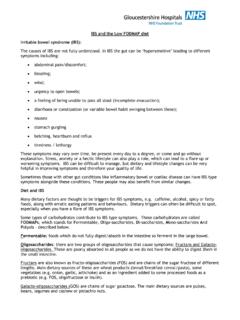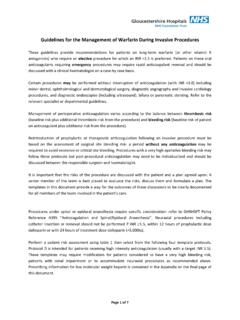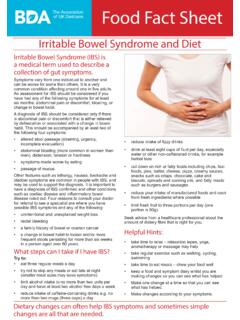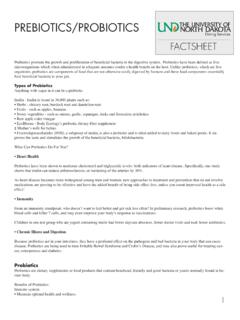Transcription of The Low FODMAP diet
1 IBS and the Low FODMAP diet irritable bowel syndrome (IBS): The causes of IBS are not fully understood. In IBS the gut can be hypersensitive leading to different symptoms including: abdominal pain/discomfort; bloating; wind; urgency to open bowels; a feeling of being unable to pass all stool (incomplete evacuation); diarrhoea or constipation (or variable bowel habit swinging between these); nausea stomach gurgling belching, heartburn and reflux tiredness / lethargy These symptoms may vary over time, be present every day to a degree, or come and go without explanation. Stress, anxiety or a hectic lifestyle can also play a role, which can lead to a flare up or worsening symptoms. IBS can be difficult to manage, but dietary and lifestyle changes can be very helpful in improving symptoms and therefore your quality of life.
2 Sometimes those with other gut conditions like inflammatory bowel or coeliac disease can have IBS type symptoms alongside these conditions. These people may also benefit from similar changes. diet and IBS Many dietary factors are thought to be triggers for IBS symptoms, caffeine, alcohol, spicy or fatty foods, along with erratic eating patterns and behaviours. Dietary triggers can often be difficult to spot, especially when you have a flare of IBS symptoms. Some types of carbohydrates contribute to IBS type symptoms. These carbohydrates are called FODMAPs, which stands for Fermentable, Oligo-saccharides, Di-saccharides, Mono-saccharides And Polyols described below . Fermentable: foods which do not fully digest/absorb in the intestine so ferment in the large bowel.
3 Oligosaccharides: there are two groups of oligosaccharides that cause symptoms; Fructans and Galacto-oligosaccharides. These are poorly absorbed in all people as we do not have the ability to digest them in the small intestine. Fructans are also known as fructo-oligosaccharides (FOS) and are chains of the sugar fructose of different lengths. Main dietary sources of these are wheat products (bread/breakfast cereal/pasta), some vegetables ( onion, garlic, artichoke) and as an ingredient added to some processed foods as a prebiotic ( FOS, oligofructose or inulin). Galacto-oligosaccharides (GOS) are chains of sugar galactose. The main dietary sources are pulses, beans, legumes and cashew or pistachio nuts. Disaccharides: Lactose is a sugar found in all animal milks.
4 Milk and yogurt are main sources of lactose Monosaccharides: Fructose is a simple sugar but in excessive amounts may be poorly absorbed by some. And Polyols: Polyols are sugar alcohols such as sorbitol, mannitol and xylitol. These are poorly absorbed in most people. These occur naturally in some fruits and vegetables, but are also used as artificial sweeteners in sugar free chewing gum, mints, and other low calorie or sugar free products. Even though some FODMAPs are poorly absorbed in everyone, they only need to be restricted if they cause symptoms. People with IBS-like symptoms appear to be sensitive to the gases produced and water changes in the large intestine that occur when the diet contains lots of FODMAPs. Reducing the intake of FODMAP s has been shown to improve gut symptoms in most individuals with IBS-like symptoms.
5 Following the diet : How strict do I need to be? Try to follow the low FODMAP diet as closely as possible to give you the best chance to improve your symptoms. Usually 4-6 weeks is long enough to identify if symptoms will respond to a low FODMAP diet . After the initial 4-6 weeks it is important that you reintroduce the avoided foods to identify which particular groups of carbohydrate cause you symptoms. Sensitivity to FODMAPs varies between people, and reintroduction to FODMAP containing foods is often well tolerated. Although a low FODMAP diet can be nutritionally balanced, working out what you are most sensitive to helps to increase food choices in your diet . The tables below provide an overview of the foods needing to be avoided and those that can be eaten whilst following a low FODMAP diet .
6 It is not an exhaustive list. Further details on other foods and safe quantities can be found on the Monash University or low FOMDAP food maestro apps: (scroll down to bottom half of the webpage) The foods listed below do not contain any FODMAPs and may be eaten freely: Meat, poultry, fish, eggs or vegetarian protein foods. Eat 1-2 portions per day. One portion is 75-100g or 2 eggs. Fresh and frozen without sauce or coating: beef, chicken, duck, lamb, pork (including bacon and ham), turkey. Fresh or frozen shellfish, white fish, oily fish. Tinned fish in brine or oil. Eggs (boiled, fried, poached, scrambled). Firm tofu, tempeh. Quorn (Check ingredients: some varieties contain onion and/or garlic) Textured vegetable protein (soya mince) Fats, oils & spreads For a healthy diet try eating less foods containing fat.
7 Fats are high in calories so use sparingly, and can contribute to IBS symptoms in some people. Chose polyunsaturated or monounsaturated where possible. Cooking oils, margarines, low fat spreads, butter, ghee, lard, suet. Starchy Foods Minor wheat ingredients in a food do not need to be avoided ( thickeners and flavourings). Foods to avoid (high in fructans, GOS or polyols): Suitable foods But check ingredients label for problem fruit, FOS, inulin, oligofructose. Cereal Grains - Wheat (including bulghur wheat, couscous, semolina) - Rye, - Barley - Amaranth Cereal grains and starchy foods Rice (and rice bran), oats (and oat bran), tapioca, potatoes, buckwheat, polenta, corn, quinoa Bread All wheat bread and rolls: white, wholemeal, multigrain , sourdough (small amounts may be ok) Pitta bread, bagels, ciabatta, focaccia, Panini, naan bread, chapatti Croissants, muffins, brioche, pastries crumpets and most bakery goods Garlic bread, pizza bases Rye bread, spelt bread.
8 Bread Wheat free / Gluten free bread and rolls Bread made from: oat, rice, corn, tapioca, potato flours 100% spelt sourdough (only) Wheat free or gluten free pizza bases, pitta bread, ciabatta, naan bread. Homemade wheat free bread using a breadmaker is a good option Flour All wheat flour white, wholemeal, plain, strong, self-raising Rye, barley, gram (Chick Pea) flours coconut flour, spelt flour, soya flour Flour and raising agents Wheat free / gluten free flour, buckwheat, cornflour, millet flour, maize flour, polenta, potato, rice flour. Baking powder, bicarbonate of soda, cream of tartar, yeast. arrowroot, Pasta and noodles All fresh and dried pasta (white and wholemeal), Gnocchi, spelt pasta, chick pea /lentil pasta Egg noodles, Hokkein, Udon, Pot noodles, Supernoodles, Ramen Pasta and noodles Wheat free / gluten free pasta (not made from lentils/chickpeas), buckwheat, quinoa pasta Rice noodles, buckwheat noodles, kelp noodles Breakfast cereals Wheat or bran based cereals (weetabix, shredded wheat, bran flakes, All-bran, cheerio s, muesli), wheat bran, wheat germ, spelt flakes Breakfast Cereals Porridge / oat cereals, oat bran cornflakes, rice krispies, some wheat free or gluten free muesli and cereals (check fruit).
9 Savoury Biscuits Water biscuits, crisp breads, Cornish wafers, cream crackers, spelt crackers Rye crispbreads Savoury Biscuits / snacks Rice crackers, corncakes, oatcakes, wheat free or gluten free crackers. Plain / salted popcorn or plain crisps Sweet Biscuits All biscuits made with wheat flour (digestives, shortbread, rich tea, custard creams etc) Sweet biscuits Some Florentines, macaroons, oat based biscuits, flapjacks. Most free from biscuit varieties Cakes All cakes made with wheat flour (fruit cake, fairy cake, Victoria sponge, chocolate cake etc) Cakes Flourless cakes, meringues, cornflour sponge. Most free from varieties are wheat free. Pastry All pastry made with wheat flour (shortcrust, puff, flaky, filo,) Shop brought pastry and pastry goods (pies, quiche, pasties) Pastry Wheat free or gluten free varieties and mixes.
10 Breadcrumbs and batter Crumbed fish and poultry, fish fingers, fish in batter, tempura batter, scotch eggs. Breadcrumbs Polenta, oats, cornflake crumbs, gluten free breadcrumbs/ batter Fruit and Vegetables Foods to avoid Suitable Fruit (Fresh, dried or juice) Apple, Apricot, Blackberry, Cherries, Dates, Figs, Mango, Nectarine, Peach, Pear, Plum/prune, Sultanas, Watermelon, Tinned fruit in apple or pear juice. Tropical fruit juice, or juices from fruits above Jams, sauces or chutneys containing fruits above. Fruit Aim for 3 portions, but spread through the day. One portion at a time= 80g fresh fruit, 1tbs dried fruit or100ml fruit juice. Portion sizes in brackets are for fruits which must be more strictly limited*. Banana, Blueberry , Cantaloupe , Clementine, Cranberries, Galia melon, Grapes, Grapefruit* (<half, small), Honeydew melon, Kiwi, Lemon, Lime , Lychee* (<5) Mandarin, Orange, Passion fruit, Papaya, Pineapple, Pomegranate*(half small) Raspberry, Raisins Rhubarb, Strawberry Vegetables Vegetables with * may be eaten in very small quantities (<3tbs /day).












